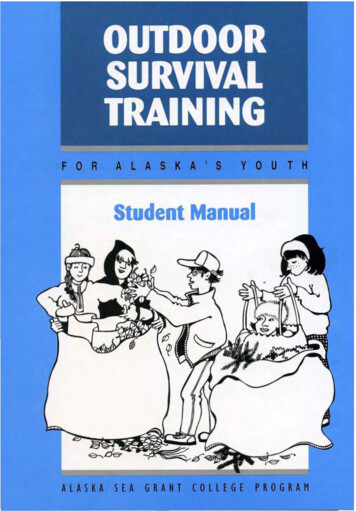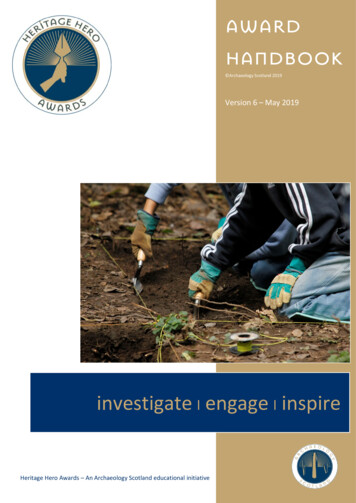
Transcription
F ORStudent ManualALASKA SEAGBA 1,
OUTDOORSURVIVALTRAININGFORALASKA'SYOUTHStudent ManualDolly GarzaAlaska Sea Grant College ProgramUniversity of Alaska FairbanksFairbanks, Alaska 99775-5040(907) 474-6707Fax (907) 474-6285SG-ED-17
Elmer E. Rasmuson Li brary Cataloging-in-Pubhcation DataGarza, Dolly A.Outdoor survival training for Alaska's youth.(SG ·ED ; 16·17)Contents: [ 1) Instructor Manual- [2) Student Manual.1. Survival skills-Study and teaching (Elementary). 2. Wilderness survival- Study andteaching (Elementary) . I. Alaska Sea Grant College Program. II. Title. III. Series: Sea GrantEducation Publication; no. 16- 17.GV200.5.G371993Second Printing 1998CreditsCover and book design are by Lisa Valore, illustrations are byNancy van Veenen, and editing is by Sue Keller.Supplemental funding for this book was provided by (1) Emergency Medical Services Section, Division of Public Health, AlaskaDepartment of Health and Human Services, through an EMS forchildren grant from the U.S. Department of Health and HumanServices, Public Health Service, Health Resources and ServicesAdministration, Maternal and Child Health Bureau; (2) SoutheastAlaska Women in Fisheries (SEAWIF); and (3) University of AlaskaFairbanks Cooperative Extension 4-H Youth Program.This book is the result of work sponsored by the University ofAlaska Sea Grant College Program, which is cooperatively supported by the U.S. Department of Commerce, NOAA Office of SeaGrant, under grant no. NA90AA-D-SG066, projects A/71-01 and A/75-01; and by the University of Alaska Fairbanks with state funds.The University of Alaska is an affirmative action/equal opportunityemployer and educational institution.Sea Grant is a unique partnership with public and private sectors combining research, education, and technology transfer forpublic service. This national network of universities meets changing environmental and economic needs of people in our coastal,ocean, and Great Lakes regions.
table DfCDnfenfsChapfer I.Prepare for an EmergencyHow to Increase Your Chances of SurvivingAn EmergencyHow to Get Ready for a TripLost Boy Rescued After 5 DaysBoy Bounces Back After 5 Days on the HillChapfer 2.Seven Steps to Survival1. Recognition2. Inventory3. ShelterClothingEmergency ShelterGarbage Sleeping BagDebris BedDebris Hut Shelter4. Signals5. Water6. Food7. PlayHow to Build a FireNote Taking GuideSurvival Crossword PuzzleChapfer 3.77891011121417181920212328Survival KitsBuilding a Survival KitChapfer 'I.12529Cold Water Survival SkillsDrownings in Alaska's WatersPreventing DrowningSelf-RescueHuddle Position, H.E.L.P. PositionSurvival Times in Cold WaterPersonal Flotation DevicesHow to Put on a Survival Suit FastIn and out of the Water with a Survival SuitRescuing Others333435373840Survival Books to Read413131About This BookTllis student manualDt:.C.IJmpanies aninsfructDr manualUlUrS8 onror aDutdoof'survival training forI1laska's youth. ltiswritten based onexperiences in the GuH' ofI1la8ka. but it {.On 6e usedin ather gp.agraphicregions too.This is your Ol n copy.l1iter you U8e if far thesurvival daM. take ithome and share it withy our family and friends.32iii
About the AuthorDolly Garza, associate professor with the University of AlaskaFairbanks , School of Fisheries and Ocean Sciences, has workedfor the Sea Grant Marine Advisory Program for ten years. Garza isan instructor and board member for the Alaska Marine SafetyEducation Association. She has been teaching outdoor survivaland water safety skills to southeast Alaska students since 1985.Garza has a B.S. in fisheries from the University of Alaska and anM.S. in fisheries from the University of Washington , and she is aPhD. candidate at the University of Delaware.Dolly GarzaMarine Advisory Agent1297 Seward Ave.Sitka, Alaska 99835(907) 747-3988Thanks to Curriculum ReviewersThe curriculum in this book is based on the Alaska Marine SafetyEducation Association's Marine Safety Instructor Training Manual.The curriculum manuscript was reviewed by the Curriculum Review Committee, who made significant improvements to the content and form , and made additions to the materials to ensure it isrelevant to students in grade schools and high schools.I would like to thank the Curriculum Review Committee: MaryBecker, Susan Hanson, and Lesley Lyman of Marie Drake MiddleSchool, Juneau ; Margie Esquiro of Verstovia Elementary School,Sitka; Judith Bronson of the Alaska Marine Safety Education Association; Hank Reed of the Sitka U.S. Coast Guard Air Station; andFlorence Smith, retired curriculum author of Sitka.In addition , several teachers encouraged me to continue thiswork and allowed me to use their classrooms as a testing ground.A thank you to Carolyn Gardner, Craig School; Peter O. Kimzey,Southeast Island School District; and Mary Becker, Susan Hanson,and Lesley Lyman, Marie Drake Middle School, Juneau.Thanks also to reviewers Jerry Dzugan, Alaska Marine SafetyEducation Association; and John Ball, Educational Programs, National Oceanic and Atmospheric Administration, Rockville, MD.Mary Becker and Lesley Lyman also reviewed the Student Manual.- Dolly Garzaiv
f you spend a lot of time outdoors, you can find yourself in anemergency at any time. Which of these outdoor activities areyou involved in-fishing , hiking, boating, berry-picking, hunting, camping, wildlife watching, and playing?IIt is important to think "it can happen to me." You should preparefor an emergency before leaving home or you may not have theright equipment or skills to face an emergency situation.Someone who is lost, or tossed into an emergency, may panic.Fear, cold , and being tired, hungry, or thirsty are all normal feelingsin an emergency situation. You must learn to overcome thesefeelings. Develop the attitude that you will survive.Don't go out adventuring in the woods or on the water if you are notin good health. If you find yourself in an emergency, your poorhealth may work against you.How to Increase your chances of surviving anemergency: Think positiveWANT to surviveBe in good healthLearn survival skillsTake along survival equipmentHow to get ready for a trip:, 1. Check the weather forecast. Ask elders .and other experienced adults what they think the weather will be like.2. Know the following: Where you are going The route you are taking How long it will take to get there How and when you will be coming back3. Tell at least one adult your plans and let them know at whattime they should call for help., It Is very Importantto prepare for anemergency BEFORE4. Never travel alone, especially if you don't know the area well.It is best to travel in groups of three or four. If someone has anaccident, the second person can go for help and the third personcan stay with the injured one.S. Take the right clothes and gear. Take long underwear, rainpants, rain jacket, extra mittens, socks, a hat, and a survival kit.Dress in layers. Wool and polypropylene are the best insulativematerials. Cotton is a poor insulating material, even though cottonjeans are what most people wear. Insulation traps the body's heatnext to the body.leaving home.Read fhe follOl»ing Mariesa60uf Jeffrey Young. thinkabouf whaf Jeffrey hadgoing for him. iJJhaf shouldhe have done fa make ifeasier for his reswers fafindhim?f
The Daily SentinelSitka . .\Iaska:\ionda ' .\11 'list 2-4.Il)X Lost Boy Rescued After 5 DaysSearcher Finds 9-Year-Old In Good Shape On Gavan HillBy Allen SykoraSentinel Staff Writer"Hey, myname is Jeff." The child'svoice from a wooded ravine led DaveCaldwell to nine-year-old JeffreyYoungSundaymorning. The boy wasrescued safe and sound after fivenights in the woods without shelterand only berries to eatSince Wednesday morning, theboy had been the subject of one of themost intensive missing personsearches in Sitka history.Rescuers and a doctor at Mt.Edgecumbe Hospital all described theboy as in remarkably good conditionfor his ordeal. He was found by amember of a volunteer search teamhigh on Gavan Hill at about 11 a.m.Sunday.Because of the rugged terrain, ittook a couple of hours for rescuers toadminister first aid and carry him tothe nearest road, where an ambulance was waiting to take him to MtEdgecumbe Hospital."He's doing remarkablywell," saidDr. Thomas Krahn, who said the boysuffered only some swelling of thefeet and some bruises."He's one of the healthiest peopleI've seen today," said the Mt.Edgecumbe hospital staff physician.After the examination, Jeffrey wastaken to a room to rest and recover.The news of the rescue came as ateam of bloodhounds and their handlers, expenses covered by volun-teers, were being flown to Sitka foranother attempt to solve the mysteryof the disappearance of the boy, on ahillside in direct view of most Sitkaresidents. Jeffrey had last been seenTuesdaymorning byhis brotherTom,from whom he had become separated as Tom was hunting deer onthe hill.Joyous family members andfriends lined the hospital hallwayoutside the emergency room Sundayafternoon while the boy was beingexamined upon arrival byambulance.He raised his head and flashed thema big smile as he was wheeled out toa hospital room.Dave Caldwell, who found the boy,was in a team with Rod Lowe andKevin Kambak. Theyborrowed a twoway radio from the fire hall andheaded up Gavan Hill early Sundaymorning, following a trail that begins behind the city landfill.They made their way to some cliffs,which seemed a likely spot for a closerlook. Caldwell walked above the cliffs,while the other two men were below.Theywere calling out to each otherto keep track of the whereabouts oftheir own team members in thenearby brush, Caldwell said. At onetime he was out of earshot of theothers, so when they got back withinhearing distance they shouted thatthey would continue their respectivecourses until they could meet backon the trail.Copyright The Daily Sentinel, Sitka, Alaska. Reprinted with pennission."I went along for a while and lostvocal contact again," said Caldwell,"so instead of calling Rod's name, Icalled Jeffs name."Caldwell said he had not beencalling the boy's name all day, butthe third time he called out the boy'sname, a child's voice answered."He said, 'Hey, my name is Jeff,'"said Caldwell.Caldwell said he was stunned tohear the young voice from nearby,and scarcely believed his ears. Buthe quickly followed the voice to agully, where he spotted the boy.Jeffrey was standing, but said hehad a hurt leg. His clothes were wetfrom the waist down."He sure was glad to see somebody," said Caldwell. Caldwell happened to be the carrier of the twoway radio carried by his party. Hecalled in the news that the town hadbeen praying for: JeffreyYoung hadbeen found alive and well.Caldwell fired two shots to summon his companions, but they wereunable to find him until helicopterpilot Arnie Johnson directed themto the spotDon K1uting, amemberofthe firedepartment's search and rescueteam, was with a group beatingthrough brush behind the PublicSafety Academy, when he heardCaldwell's broadcast The messagehad not been picked up at the firehall, so K1uting relayed the news.
Lost boy"Then we ran up the hill," he said."The kid was in really high spirits," said Kluting. "He was happy, hewas able to get up and walk." Nevertheless, the rescuers broughtJeffreydown the mountain on a stretcherthat had been lowered by the helicopter.Johnson was unable to find anyclearing in the vicinity big enough toland the helicopter, which would havebeen necessary to get him aboard.The professional search and rescue personnel who first reached Jeffrey sent a radio message to the firehall that the boy complained of aninjured leg, but that his vital signswere in the range of normal. As aprecaution, they placed him in a hypothermia warming bag and strappedhim to the stretcher.News of the rescue Quicklyspreadthrough town. Throughout the community, the yellow and white helicopter was clearly visible hoveringabove the hillside, marking theprogress of the recovery party. In atleast one church the news was received only moments after the congregation had prayed for Jeffrey'ssafe return.Alarge crowd gathered at the baseof the main Gavan Hill trail, whichbegins at the end of Baranof Street.Jeffrey's parents, family members,friends, and curious onlookers hadwalked up the path a couple hundredyards to the first open muskeg area,and cheered and hugged one another as rescuers emerged from thewoods carrying the boy, wrapped fromhead to toe in the rescue blanket.Without pausing, the litter bearersplaced Jeffrey into the waiting ambulance. Family hugged and shookhands with Kambak, Caldwell, andLowe."I think I was happier than hewas," said Caldwell about his feel-Continued from page 2ings when first coming across theboy. "And he was pretty happy. If itwasn't for Jehova looking out foreveryone, we wouldn't have foundhim. God is the one who led usthrough. That's who I've got tocredit."Two factors that worked inJeffrey's favor were the unusuallywarm and sunny weather of recentdays, and the nearby trickle ofwaterthat flowed through the gully inwhich he was located. Dr. Krahnand rescue personnel agreed that ifit had been as rainy as usual inSitka, without shelter the boywouldhave been at riskoflife-threateninghypothermia.And Kluting observed that whilea person can survive for long periods without food, he can't last morethan a couple of days without water.Caldwell said Jeffrey told him hewas able to see the Coast Guard andprivately owned helicopters overhead during the five days of searching, but that he had not been able tosignal them. However,said Caldwell,the boy told him he had not heardthe voices of any of the scores ofsearchers on the ground until thefinal day. It was not immediatelyclear how long Young had been atthe spot he was found.Caldwell said the boy told him hehad eaten some berries early in theordeal, but that he had eaten nothing for the last couple of days beforehis rescue, because there were noberry bushes in the gully. From thegully, the boy could see the town andairport, Caldwell said."I've got to hand it to Jeffrey,"said Caldwell. "He's a strong boy."Caldwell said the boy told him thathe and his older brother had oftengone into the woods. "He said hisbrother was top of the world," saidStory continues on page 4. In Jeffrey's favorwere the unusuallywarm and sunnyweather of recent days,and the nearby trickleof water that flowedthrough the gully Inwhich he was located. while a person cansurvive for long periods without food, hecan't last more than acouple of days withoutwater.3
Lostboy ---- Continued from page 3. if It had been asrainy as usual in Sitka,without sheher the boywould have been at riskof life-threateninghypothermia.Caldwell.Authorities had suspended the official search Friday night after theintensive effort ofthe previous threedays had not located the boy. Up tothat time, said a fire departmentspokesman, "official" search partieshad spent more than 3,000 searchhours on the ground in the woods,and an undetermined hundreds ofadditional hours had been put in byothers, including family memberswho went out on their own.Helicopters spent 32 hours in theair during the search, including 15.6hours of flight time in which theCoast Guard was using infrared bodyheat detectors, said the fire departmentspokesman: He added that threedogs and their handlers fromJuneauhad spent 100 hours in the woods.Although the "official" search wassuspended, some 80 volunteers, in·cluding members of the fire depart·ment, used the fire hall as a startingpoint for their efforts on Saturdayand Sunday.And,as on previous days,an undetermined number went intothe woods to search without check·ing in.Early Thursday night searchers'hopes had been buoyed when a teamheaded by Kluting discovered a siteon the hillside where they believedthe boy had spent a night.Under the fallen tree someone hadlined up sticks to form a wall. Therewere a child's footprints, where dirtwas kicked against the side. Caldwellsaid the boy, when rescued, confirmed he had spent one night undera log.Friday's search from the log shelter went down into the Indian RiverValley, which seemed to be the direction the small footprints led. Searchers formed a long line, spaced about10 yards apart, and plowed throughdevil's club, blueberry bushes, anddeadfalls for the rest of the day.Kluting said it now appears thatJeffrey went around the side ofGavan Hill and actually climbedhigher, to within about 500 feet fromthe top. At one point, continuedKluting, the boy must have actuallycrossed the main Gavan Hill trail,apparently without recognizing it,in order to have reached the spotwhere he was found.Many Sitkans took off from workand gave up leisure time to beatthrough the brush, and many othersdonated food and beverages for thesearch teams.Searchers ranged from teenagers to men over 60, who lugged backpacks through the woods all day.Many commented that they weremotivated by visions of how theywould feel if it were their own childlost in the woods.Jim and Nancy Hope used theirown credit card to advance the expenses of the three bloodhounds andtheir trainers Sunday.Said Caldwell, also afather, whenthe search was ended, "I kept thinking how his folks must feel. Acoupledark nights, it really bothered me. Iknew he was still out there somewhere. I had a gut feeling."
The Daily SentinelSitka. AlaskaTlI ,s la\ \1I ",,'2 .19tCBoy Bounces Back After 5 Days On HillBy Allen SykoraSentinel Staff WriterNine-year-old Jeffrey Young sayshe "wasn't ever scared" during hisfive days and nights alone on GavanHill, but adds he'd rather see peoplethan trees."The boy spoke about his adventure this morning in his Mt.Edgecumbe Hospital room as heopened a model airplane, one of themany gifts from the steady stream offamily and friends who have visitedhim.Jeffrey was reported missing oneweek ago today, when he becameseparated while following his olderbrother Tom on a hunting trip. Thebrother reported that he left Jeffreyon the trail to rest, but that Jeffreywas no longer there when he re,turned.Jeffrey said he waited for sometime, and then decided to walk backto town, and got lost. He said hespent one night underneath a log,forming a wall on one side by arranging sticks. Searchers found thisplace Thursday night, and the discovery spurred new hope for findingthe boy.Jeffrey said he left that shelterand wandered on, until he ended upin the steep gully where he was finally located by a volunteer searcherSunday morning."I was trying to come back to townand my leg started to get sore," hesaid today. "I decided to stay thereand wait for someone to find me.That's the only way I'd make it."The examining doctor said Jeffrey was in generally good condition. He suffered some bruises andswollen feet."I wasn't ever scared at all," saidJeffrey. However, he said, whensearcher Dave Caldwell walkednearby shouting his name, "I waspretty happy to hear a voice. It'sbetter to see people than it is to seetrees."Jeffrey said he made a bargainwith God while on the hill."I asked him if I could go home,then I wouldn't fight with my momany more. I was thinking about getting home and stuff, and riding mybike. Only now I can't," due to hisswollen feet, he said.Dr. Thomas Krahn said no decision had been made on when theyouth would be discharged from thehospital. The Mt. Edgecumbe staffphysician saidJeffreywas being heldfor observation due to the swollenfeet.Jeffrey said he didn't get hungrythe first couple of days because of anabundance of berries. "There was abunch of salmonberries up there,"he said.But he ended up in a gully hecouldn't get out of and during hislast two days on the hillside he hadaccess only to water, he said.Jeffrey will enter the third gradein the fall. He said he had neverhiked up Gavan Hill before,althoughhe had been on top of nearby HarborMountain. The story of the searchand subsequent rescue of Jeffreyhas received national attention. Hismother, Jennifer Young, said todaythat she has received telephone callsfrom the International News Service and NBC News.BeginningWednesday,Sitkares-cue personnel and volunteers spentthousands of hours combing GavanHill and the Indian River Valley. .Inaddition, Coast Guard and privatehelicopters spent 32 hours searching for the youth.In addition, more than 100 doghours were logged by official searchparties, and preparations were under way to bring in bloodhoundswhen Jeffrey was found on Sunday.SEADOGS,aJuneau-basedgroupthat makes their trained trackingdogs available for searches, broughttwo golden retrievers and one German shepherd into the search. Agolden retriever owned by Sitka Volunteer Fire Department memberKaren Royce was also on Gavan Hill.Some volunteers brought theirown dogs to help search at varioustimes, authorities said.The SEADOGS (Southeast AlaskaDogs) are trained to follow the airborne scent of a search subject, explained coordinator Bruce Bowler.The dogs run freely and follow voiceand hand commands.On the other hand, he said, bloodhounds are generally deployed on aleash and follow the scent trail onthe ground. Experienced bloodhounds can also follow an airbornescent, he said.Besides "trailing," SEADOGS aretrained to sniff out victims in caveins, earthquakes and avalanches,said Bowler. The handlers also undergo intensive training, not onlyintrailing with the dogs, but in use ofcompass and maps, first aid, andwilderness survival, so they are prepared to enter unfamiliar wilderness terrain, said Bowler.
he Seven Steps to Survival will help improve your survival skillsand positive thinking. These seven steps came from peoplewho survived emergencies.T1. RecognHJon"Oh no-I'm in trouble!"The most important step is recognizing that you are in an emergency. If you don't recognize when you're in an emergency, youcan die.Most people don't admit they are in trouble until they are in themiddle of an emergency. Here are some situations that could beemergencies: If you are out berry picking with your brother and youseparate from each other, are you in danger? What if it isgetting dark and you're not sure where you are or how toget back home? If you are out boating and your outboard starts sputtering,are you in an emergency? What if your engine dies and youstart drifting toward a big rock?If you 're not sure that you are lost or in trouble, assume you are.Many people fail to recognize that they are in trouble . Many havedied because they were too "tough" to accept this fact.2. Inventory"What do I have wHh me?What should I do?"SevenSteps toSurvivalYou must think about what you have going for you and what youhave going against you.5 - SitT - Think0 - Observep - PlanAn inventory has three parts:o First,treat anyone who is seriously injured or hashypothermia.If you are with someone who is hypothermic, you can warm himor her with your own body heat inside jackets or sleeping bags.7
f) Second. find a nearby spot that is protected from cold.wind. and rain .If you are along the shore. you should go into the woods toprotect yourself from the rain and wind .@) The third part of inventory is to find what you can use thatwill help you stay alive.See what you have on you (such as a knife or a mirror) andwhat you can use from the land (such as driftwood or plasticjugs) to improve your situation. It is very important to have asurvival kit on your body-NOT left on a boat or somewhereelse.3. Shelter ". need to stay warm!'People who die in survival situations generally die from one of twocauses- drowning or hypothermia.Hypothermia happens when the body's temperature gets lower.The symptoms are shivering. feeling depressed . slurred speech.and lack of coordination.Protect yourself from hypothermia by staying dry and warm.8
Clothing is your primary shelter. When you get ready to go on anouting , dress for the worst weather.CIDthingAlways dress for an emergency or take warm clothes along. Always take a hat. 50% to 75% of the body's heat can be lost from thehead.lIJe 6e8f way to dress fbr anDUting is in foyers. iJJoof andpofypropyfene are 6effer thanwffon 6ewuse they arewarmer and they insufateeven when they are wet.9
EmergencyShelterYou can build an emergency shelter to protect yourself from thewet and cold .A good shelter must be: SmallInsulativeWindproof and rainproofA shelter traps heat next to your body. The shelter must be small,since your body will be the only heater. The insulation helps keepthe heat in, and plastic or branches help keep it dry.When selecting a place to build your shelter, look for a place out ofthe wind and rain . Be sure your site has good drainage.You could build three kinds of emergency shelters: Garbage sleeping bagDebris bedDebris hutYou can make a garbage sleeping bag or a debris bed in a hurry,in an emergency situation :. If someon is hypothermic and needs help right awayIf it's getting dark and you need to build something fastIf you don't have the equipment or energy to build something betterIt will take more time to build the debris hut shelter. If you have thetime to build it, the debris hut shelter will last longer and will do amuch better job of protecting you .ro .
Garbage Sleeping BagThe garbage sleeping bag is just the right size for small kids (fiveor six years old) .Start with one garbage bag and fill it with moss, leaves, grass, ortwigs.Then hollow out the center and put another garbage bag in it. Nowyou have a garbage sleeping bag . Is it small , insulative, andwindproof and rainproof? Yes, but the insulation is not the best.When you are inside a garbage sleeping bag, you should wear awool hat. Your head should stick out of the bag . Why? If youbreathe in the bag, water from your breath will get inside the bag .Will the garbage sleeping bag fit a big person? No.II-- '- -,-- .- ,-Pur (he garbage s feepingbag next (0 a fog Dr (ree,(0 help keep you ou( of(he wind Dr rain.ff
Debris BedIf you are in immediate danger and are too big to sleep in agarbage sleeping bag , you can build this debris bed.To make the debris bed :o Start the bed with alayer of branches 1or 2 feet deep.8Cover with 1 or 2 feetof moss. Make thelayers thick , becausewhen you lie downthe bed will flatten .@)Cover the moss witha plastic sheet or agarbage bag cutopen.e To make the blanket,top the bed withanother layer ofplastic (plastic toplastic).o. \ ltll , ::Ii!N-55 7 - -----55---------- 12I, "'." Cover the secondlayer of plastic withmoss, twigs, orbranches.
Branchesand moss/)Plaslic "" Branches and moss10 gM info fhe debrisbed, crawf befween fhepfaBfic sheefs. /s fhissheffer smaft. insufafive.rainproof, and lilindproof?/'(o-if is nof lilindproof.13
Debris Hut ShelterA debris hut shelter is made with an A-frame or a lean-to against alog. It has walls and a front door.o Start the bed with alayer of branches 2 to3 feet deep.@@)\.il.l ;::§- -- § .- § - § Cover the brancheswith 1 to 2 feetof moss.oUse three poles forthe frame . Tie withrope, roots, etc.o Strengthen framewith additional poles.Cover the moss withplastic, such as anopened garbagebag . Lie down on thebed to flatten it.A good debris hut shelter looks big from the outside, but inside itshould be just big enough to fit you. When you are inside, it shouldbe only six inches from you to the top and to each of the sides. Sixinches is about equal to the distance between your thumb and littlefinger when they are outstretched. When you lie in your shelter withthe door closed, you should not be able to see any light.
o Cover frame withplastic, or big leaves.8Put boughs on top ofthe plastic.o Cover boughs witho Place a thick layer ofmoss on top of thebranches, so youcan't see any lightfrom the inside.small branches.4IDMake a flap door withtree branches , or astuff door with plasticand moss.'5
ne more signals youhave, (he 6efferf16
4. Signals "Hey! I need help over here!"You can help search parties find you by putting up signals. To beeffective, signals must: attract attentionsend a message of distressSome signals can be carried with you in your survival kit: Signal mirrorsWhistlesFlaresReflectors (aluminum foil)LightsEPIRBS (Emergency Position Indicating Radio Beacon)VHF radioSome signals can be constructed using things that you find : Hanging clumps of trash SOS of driftwood, seaweed, or grass. Build it above thehigh tide mark. Fires and smokeRules to remember when setting up signals: The more signals you have, the better. You need signals that are visible from air, land, and sea. Signals must be large! Each letter of an SOS should be 18feet x 3 feet. Three signals mean distress. An SOS has three letters.Hang three clumps of trash from trees or drift logs. Usethree fires in a line. Use colors that contrast with the background: hang lifepreservers or bright bandanas . Moving Signals catch the searcher's eye . If you are using a fire, you must have someone on watch atall times to keep the fire burning and to make sure it doesn'tspread.Use the right signal in the right place : Forest: whistles, bright colors , something reflectiveCoastline: SOS, hang ing trash , something reflectiveFrom a boat: mirrors, bright colors, water dyes(7
s. Water"I need to avoid dehydration:'You need 6 to 8 pints (3 to 4 quarts) of water every day. How muchis 6 pints? Lots l 6 pints 8 pop cans 12 cups.If you don't get enough water, you can become dehydrated. Whatare the symptoms? Craving for cold or wet foodsDark urineHeadacheChapped lipsFeeling tired or dizzyDepressionWhen you are dehydrated your body and mind don 't work as wellas usual. If you become severely dehydrated you can die. If youdon't have any water in an emergency situation you should: Avoid a lot of activity such as hiking .Eat very little, because digestion requires water.Water that is safe to drink:.".-- I RHOG ITIOI'1 INYEN cRl1 SHELHR4567f8SIGNALSWATERFOODPLAt Rainwater collected in a clean containerWater that you brought with youWater that has been boiled for 20 minutesAll other sources of
Survival Times in Cold Water 34 Personal Flotation Devices 35 How to Put on a Survival Suit Fast 37 In and out of the Water with a Survival Suit 38 Rescuing Others 40 Survival Books to Read 41 About This Book Tllis student manual Dt:.C.IJmpanies an insfructDr manual ror a UlUrS8 on Dutdoof' survival training for I1laska's youth. ltis










